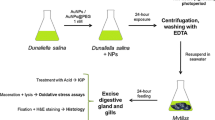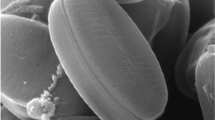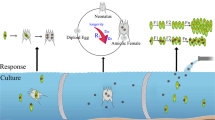Abstract
The release of engineered nanomaterials offers a significant concern due to their unexpected behavior in biological systems. In order to establish the level of threat from releasing nanomaterials into ecosystems, simplified food webs are an effective method to determine toxicity and bioassessment. A study is presented examining the behavior of citrate-capped gold nanoparticles (AuNPs) introduced into a model food chain consisting of a phytoplankton food (Ankistrodesmus falcatus) and a zooplankton grazer (Daphnia magna). UV–Vis spectroscopy is used to monitor the behavior of AuNPs in the presence of algae (Ankistrodesmus) and Daphnia over the span of 5 days. Transmission electron microscopy shows the attachment of gold aggregates to the surface of the Ankistrodesmus. Bright field microscopy shows significant accumulation of AuNPs in the gut of Daphnia via uptake of contaminated Ankistrodesmus and directly from water. No toxicity was evident for Daphnia exposed to AuNPs at the concentration used (880 µg L−1).





Similar content being viewed by others
References
Berciaud S, Cognet L, Tamarat P, Lounis B (2005) Observation of intrinsic size effects in the optical response of individual gold nanoparticles. Nano Lett 5:515–518
Bouldin J, Ingle T, Sengupta A, Alexander R, Hannigan R, Buchanan R (2008) Aqueous toxicity and food chain transfer of quantum dots in freshwater algae and Ceriodaphnia dubia. Environ Toxicol Chem 27:1958–1963
Cedervall T, Hansson LA, Lard M, Frohm B, Linse S (2012) Food chain transport of nanoparticles affects behaviour and fat metabolism in fish. PLoS One 7:e32254
Churro C, Alverca E, Sam-Bento F, Paulino S, Figueira VC, Bento AJ, Prabhakar S, Lobo AM, Calado AJ, Pereira P (2009) Effects of bacillamide and newly synthesized derivatives on the growth of cyanobacteria and microalgae cultures. J Appl Phycol 21:429–442
Daniel MC, Astruc D (2004) Gold nanoparticles: assembly, supramolecular chemistry, quantum-size-related properties, and applications toward biology, catalysis, and nanotechnology. Chem Rev 104:293–346
Draine BT, Flatau PJ (1994) Discrete-dipole approximation for scattering calculations. Opt Soc Am A 11:1491
Draine BT, Flatau PJ (2012) User guide to the discrete dipole approximation code DDSCAT 7.2, arXiv:1202.3424
Ferry J, Craig P, Hexel C, Sisco P, Frey R, Pennington PL, Fulton MH, Scott IG, Decho AW, Kashiwada S, Murphy CJ, Shaw TJ (2009) Transfer of gold nanoparticles from the water column to the estuarine food web. Nat Nanotechnol 4:441–444
Frens G (1973) Controlled nucleation for the regulation of the particle size in monodisperse gold suspensions. Nat Phys Sci 241:20–22
Haiss W, Thanh NTK, Aveyard J, Fernig DJ (2007) Determination of size and concentration of gold nanoparticles from UV–Vis Spectra. Anal Chem 79:4215–4221
Handy RD, Owen R, Jones EV (2008) The ecotoxicology of nanoparticles and nanomaterials: current status, knowledge gaps, challenges, and future needs. Ecotoxicology 17:315–325
Holbrook RD, Murphy KE, Morrow JB, Cole KD (2008) Trophic transfer of nanoparticles within a simplified invertebrate food web. Nat Nanotechnol 3:352–355
Huang WT, Levitt DG (1977) Theoretical calculation of the dielectric constant of a bilayer membrane. Biophys J 17:111–128
Jensen T, Kelly L, Lazarides A, Schatz GC (1990) Electrodynamics of noble metal nanoparticles and nanoparticles clusters. J Clust Sci 10:295
Johnson PB, Christy RW (1972) Optical-constants of noble-metals. Phys Rev B 6:4370–4379
Jürgens K, Gasol JM, Massana R, Pedrós-Alió C (1994) Control of heterotrophic bacteria and protozoans by Daphnia pulex in the epilimnion of Lake Cisó. Archiv für Hydrobiologie 131:55–78
Kelly KL, Coronado E, Zhao LL, Schatz GC (2003) The optical properties of metal nanoparticles: the influence of size, shape, and dielectric environment. J Phys Chem B 107:668–677
Kim T, Lee K, Gong MS, Joo SW (2005) Control of gold nanoparticle aggregates by manipulation of interparticle interaction. Langmuir 21:9524–9528
Kreibig U, Vollmer M (1995) Optical properties of metal clusters. Springer, Berlin
Lee BT, Ranville JF (2012) The effect of hardness on the stability of citrate-stabilized gold nanoparticles and their uptake by Daphnia magna. J Hazard Mater 213–214:434–439
Li T, Albee B, Alemayehu M, Diaz R, Ingham L, Kamal S, Rodriguez M, Whaley S (2010) Comparative toxicity study of Ag, Au, and Ag-Au bimetallic nanoparticles on Daphnia magna. Anal Bioanal Chem 398:687–700
Liu J, Lu Y (2006) Preparation of aptamer-linked gold nanoparticle purple aggregates for colorimetric sensing of analytes. Nat Protoc 1:246–252
Lovern SB, Owen HA, Klaper R (2008) Electron microscopy of gold nanoparticle intake in the gut of Daphnia magna. Nanotoxicology 2:43–48
MacCormack TJ, Goss GG (2008) Identifying and predicting biological risks associated with manufactured nanoparticles in aquatic ecosystems. J Ind Ecol 12:286–296
Majzik A, Fülöp L, Csapó E, Bogár F, Martinek T, Penke B, Bíró G, Dékány I (2010) Functionalization of gold nanoparticles with amino acid, ß-amyloid peptides and fragment. Colloids Surf B 81:235–241
Malinsky MD, Kelly KL, Schatz GC, Van Duyne RP (2001) Nanosphere lithography: effect of substrate on the localized surface plasmon resonance spectrum of silver nanoparticles. J Phys Chem B 105:2343–2350
Mulvaney P (1996) Surface plasmon spectroscopy of nanosized metal particles. Langmuir 12:788–800
Plimpton S (1995) Fast parallel algorithms for short-range molecular dynamics. J Comp Phys 117:1–19
Renault S, Baudrimont M, Dudons NM, Gonzalez P, Mornet S, Brisson A (2008) Impacts of gold nanoparticle exposure on two freshwater species: a phytoplanktonic alga (Scenedesmus subspicatus) and a benthic bivalve (Corbicula fluminea). Gold Bull 41:116–126
Tullman JA, Finney WF, Lin YJ, Bishnoi SW (2007) Tunable assembly of peptide-coated gold nanoparticles. Plasmonics 2:119–127. doi:10.1007/s11468-007-9033-z
Unrine JM, Tsyusko OV, Hunyadi SE, Judy JD, Bertsch PM (2010) Effects of particle size on chemical speciation and bioavailability of copper to earthworms (Eisenia fetida) exposed to copper nanoparticles. J Environ Qual 39:1942–1953
US Environmental Protection Agency (2002) Methods for measuring the acute toxicity of effluents and receiving waters to freshwater and marine organisms, EPA-821-R-02-012, 5th edn. US Government Printing Office, Washington
Wanga H, Wicka R, Xing B (2008) Toxicity of nanoparticulate and bulk ZnO, Al2O3 and TiO2 to the nematode Caenorhabditis elegans. Environ Pollut 154:1171–1177
Wetzel RG (2001) Limnology. Academic Press, San Diego
Williamson CE, Butler NM (1987) Temperature, food and mate limitation of copepod reproductive rates: separating the effects of multiple hypotheses. J Plankton Res 9:21–836
Yang WR, He ZC, Gooding JJ, Chen G (2007) Optical detection of copper ions using l-Cysteine functionalized gold nanoparticles. J Nanosci Nanotech 7:712–716
Zhu X, Wang J, Zhang X, Chang Y, Chen Y (2010) Trophic transfer of TiO2 nanoparticles from daphnia to zebrafish in a simplified freshwater food chain. Chemosphere 79:928–933
Acknowledgments
The work has benefited from the facilities available through Temple University’s College of Science and Technology. Temple University’s Owl’s Nest high-performance computing cluster was used to carry out DDA simulations. KDG acknowledges support received through a Temple University Graduate Student Fellowship. RWS acknowledges support for supplies from Temple University’s Indirect Cost Recovery Program.
Author information
Authors and Affiliations
Corresponding author
Electronic supplementary material
Below is the link to the electronic supplementary material.
Rights and permissions
About this article
Cite this article
Gilroy, K.D., Neretina, S. & Sanders, R.W. Behavior of gold nanoparticles in an experimental algal–zooplankton food chain. J Nanopart Res 16, 2414 (2014). https://doi.org/10.1007/s11051-014-2414-2
Received:
Accepted:
Published:
DOI: https://doi.org/10.1007/s11051-014-2414-2




